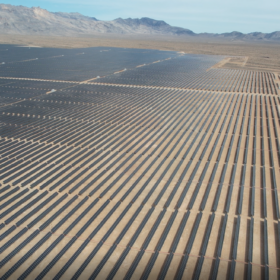Vertical agrivoltaics for forage crops, animal grazing
US-based Sunstall has deployed a vertical agrivoltaic facility based on its racking solution in the United States. The system features 18 rows of 21 panels and has a total capacity of 170 kW.
Californians could see up to $128 fixed charge added to their monthly electric bill
The monthly charge would be assessed regardless of any energy conservation efforts or solar production at home. Eighteen California Congressional representatives wrote a letter to the Public Utilities Commission warning the proposed charge would harm low- and middle income residents and “undercut investments in renewable energy.”
Weekend Read: Gray skies over Californian solar
There may be a global solar boom but a drastic revision of California’s net metering program has ruptured the industry overnight and is affecting everyone from installers to financiers to makers of power electronics.
The Hydrogen Stream: Germany mulls Namibian hydrogen investment
The German government has confirmed the suitability of Hyphen’s hydrogen project in Namibia for potential investment, while Topsoe has completed a 2,000-hour demonstration of 12 solid oxide electrolyzer cell (SOEC) stacks.
California cuts interconnection costs for distributed solar developers that agree to export limits
By agreeing to limit exports to the grid at peak generation hours, distributed energy resources like rooftop solar and energy storage can now avoid delays and costly infrastructure upgrades.
California has become rooftop solar and batteries NEM-esis
The transition to California’s new net metering, ‘NEM 3.0,’ regime was justified, in part, as a way to support residential energy storage installations but the state policy has pushed rooftop solar off a cliff.
The Hydrogen Stream: Egypt unveils hydrogen plans for Suez Canal
Egypt has clinched hydrogen deals with seven international developers, while the European Investment Bank (EIB) has agreed to support commercial production of Germany-based Sunfire’s solid oxide electrolyzers.
US developer secures $1.1 billion for California solar-storage project
Arevon Energy secured the funds for a 374 MW solar project with 150 MW / 600 MWh of co-located energy storage.
Weekend Read: Energy sovereignty
Native American lands boast serious PV potential in the United States but getting projects off the ground hasn‘t always been easy. Different tribes are willing to take power generation into their own hands and the landscape could be shifting, thanks to funding from the US Inflation Reduction Act (IRA) and other programs.
Weekend Read: PV goes portable
Portable solar generators are making their way from the fringes of solar and energy storage to become a mainstream consumer item. The rise has been charged by a range of factors that have created massive brands. Where did the sector emerge from, who was buying before, who is buying now, and what’s next? Tristan Rayner reports.










